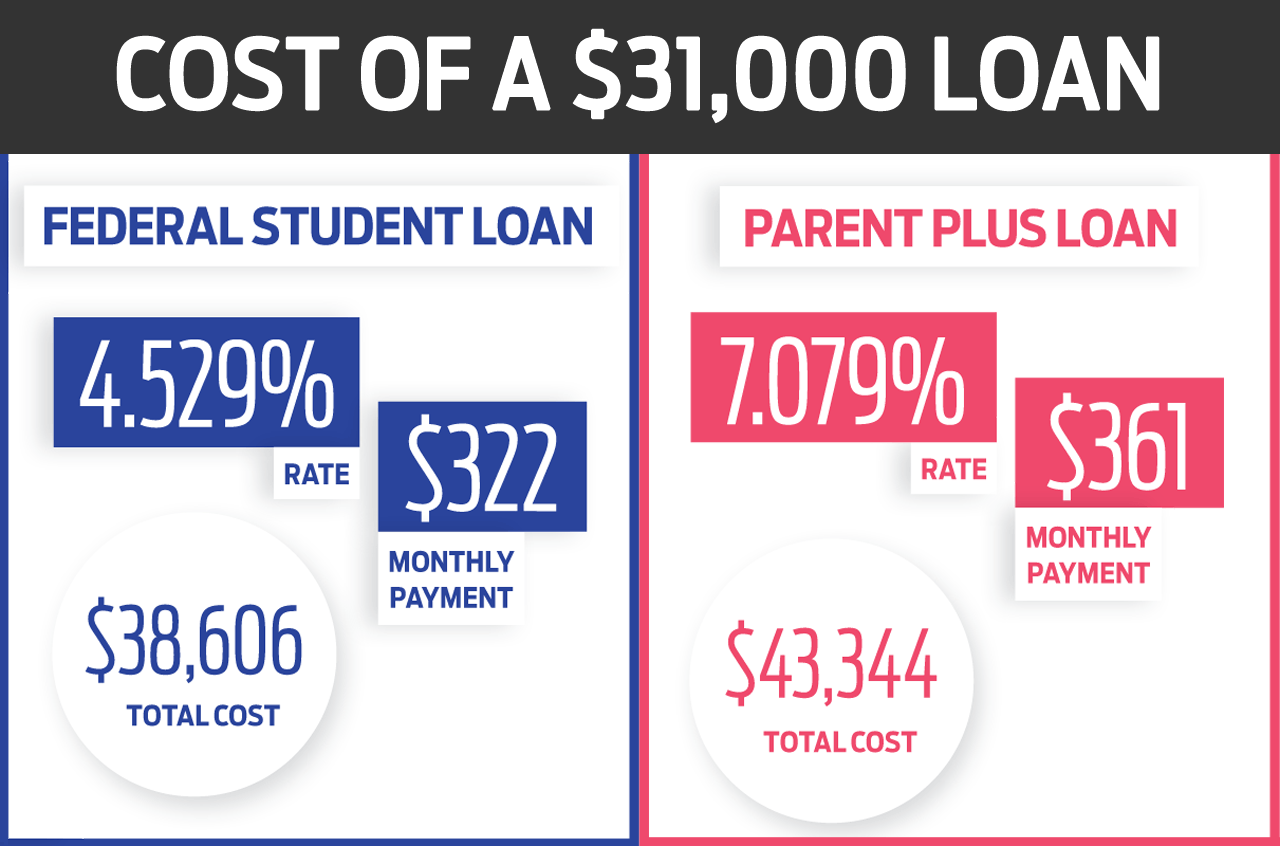The Problem With PLUS Loans
New student loan rates are lower, but parent loans are still no bargain.


Interest rates on federal student loans are set to fall by more than half a percentage point on July 1, 2019, for loans issued for the upcoming academic year. But while that will offer modest relief to new borrowers, the rate on one of the fastest-growing types of loans—parent PLUS loans—remains well above rates on other types of loans.
The rate on PLUS loans issued on or after July 1 is 7.079%, compared with 4.529% for federal Stafford loans taken out by undergraduates. That adds up: A $31,000 federal direct loan—the lifetime maximum most undergrads can borrow—paid off over 10 years would cost about $38,600 with interest, while a Parent PLUS loan for the same amount would cost more than $43,300.
PLUS loans appeal to a lot of parents because they’re easy to qualify for and can cover the full cost of attendance. The government paid out $12.7 billion in parent PLUS loans over the 2017–18 academic year, compared with $7.7 billion in 2007–08, according to Mark Kantrowitz, of Savingforcollege.com. In the 2017–18 academic year, the average PLUS loan balance was $35,600.

Sign up for Kiplinger’s Free E-Newsletters
Profit and prosper with the best of expert advice on investing, taxes, retirement, personal finance and more - straight to your e-mail.
Profit and prosper with the best of expert advice - straight to your e-mail.
A recent AARP survey found that nearly one-third of parents who had taken out a PLUS loan had difficulty making at least one payment over the course of five years. “We have a growing population of parents with tens of thousands of dollars in student loan debt,” says Betsy Mayotte, president of the Institute of Student Loan Advisors. “At 45 or 55, your spending should be focused on retirement, not loans.”

A better strategy. Some parents also want to help their children avoid debt. But with such a wide disparity in interest rates, parents may be better off having their child take out federal student loans and then helping to pay them off.
There are limits on how much a student can borrow each year in federal loans. For example, most freshmen can borrow no more than $5,500 in direct Stafford student loans. But if that’s not enough to cover expenses, there are other options that cost less than parent PLUS loans. Many schools offer interest-free tuition payment plans that stretch the length of a semester or school year. You might also be able to take out a home equity line of credit, or HELOC. The average rate on those loans, which is tied to the federal prime rate, is about 6.1%.
If you have good credit, you may find better rates through a private loan provider. The interest will most likely be a variable rate, meaning it could rise if overall interest rates move higher.
Get Kiplinger Today newsletter — free
Profit and prosper with the best of Kiplinger's advice on investing, taxes, retirement, personal finance and much more. Delivered daily. Enter your email in the box and click Sign Me Up.

-
 Stock Market Today: Stocks Soar on China Trade Talk Hopes
Stock Market Today: Stocks Soar on China Trade Talk HopesTreasury Secretary Bessent said current U.S.-China trade relations are unsustainable and signaled hopes for negotiations.
By Karee Venema
-
 2026 Disney Dining Plan Returns: Free Dining for Kids & Resort Benefits
2026 Disney Dining Plan Returns: Free Dining for Kids & Resort BenefitsPlan your 2026 Walt Disney World vacation now. Learn about the returning Disney Dining Plan, how kids aged three to nine eat free, and the exclusive benefits of staying at a Disney Resort hotel.
By Carla Ayers
-
 How Intrafamily Loans Can Bridge the Education Funding Gap
How Intrafamily Loans Can Bridge the Education Funding GapTo avoid triggering federal gift taxes, a family member can lend a student money for education at IRS-set interest rates. Here's what to keep in mind.
By Denise McClain, JD, CPA
-
 How an Irrevocable Trust Could Pay for Education
How an Irrevocable Trust Could Pay for EducationAn education trust can be set up for one person or multiple people, and the trust maker decides how the money should be used and at what age.
By Denise McClain, JD, CPA
-
 UTMA: A Flexible Alternative for Education Expenses and More
UTMA: A Flexible Alternative for Education Expenses and MoreThis custodial account can be used to pay for anything once the beneficiary is considered an adult in their state. There are some considerations, though.
By Denise McClain, JD, CPA
-
 Coverdell Education Savings Accounts: A Deep Dive
Coverdell Education Savings Accounts: A Deep DiveWhile there are some limitations on income and contributions, as well as other restrictions, a Coverdell can be a bit more flexible than a 529 plan.
By Denise McClain, JD, CPA
-
 529 Plans: A Powerful Way to Tackle Rising Education Costs
529 Plans: A Powerful Way to Tackle Rising Education CostsContributions to 529 plans grow tax-free and are not taxed when they are used to pay for qualified educational expenses for the beneficiary.
By Denise McClain, JD, CPA
-
 Roth IRA Contribution Limits for 2025
Roth IRA Contribution Limits for 2025Roth IRAs Roth IRA contribution limits have gone up. Here's what you need to know.
By Jackie Stewart
-
 Four Tips for Renting Out Your Home on Airbnb
Four Tips for Renting Out Your Home on Airbnbreal estate Here's what you should know before listing your home on Airbnb.
By Miriam Cross
-
 Five Ways to a Cheap Last-Minute Vacation
Five Ways to a Cheap Last-Minute VacationTravel It is possible to pull off a cheap last-minute vacation. Here are some tips to make it happen.
By Vaishali Varu